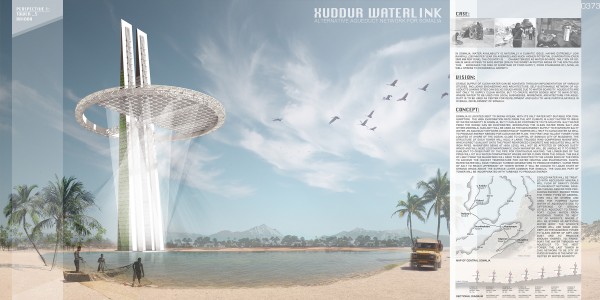Editor’s Choice
2015 Skyscraper Competition
Nurzhanat Kenenov
Singapore
Water availability in Somalia is naturally climatic issue. With extremely low rainfall and much higher potential evaporation, the country is characterized as water-scarce. Only 30% of Somalis have access to safe water, leading to increased risk of food shortage, social conflict, stress to economic growth, and poor standards of living.
A stable supply of clean water can be achieved through implementation of engineering and architectural concepts. A self-sustaining network of aqueducts linking cities will solve issues arising from water scarcity. These aqueducts will supply clean water and create water bodies next to main cities, where water to be used by local families and businesses.
Somalia is located next to Indian Ocean, with its salt water not suitable for consumption. The high evaporation rate from the hot climate is a key factor to issue of water scarcity in Somalia, but it can also contribute to its solution. Salt water from the ocean can be evaporated, separating the clean water from salt and other minerals. Sunlight will be used as the main energy supply to evaporate salty water. An aqueduct network consisting of towers will help to clean water as well to produce energy needed for clean water flow. The first and tallest tower to be located at shore of the ocean, close to capital of Somalia city of Muqdisho. The structure of each tower will hold a large trussed ring comprising magnifiers, which direct sunlight onto the front reinforced concrete and insulated wall with iron pipes. Magnifiers being at high level will not be affected by ground dusty winds and will need less maintenance. Each magnifier will be unique as it to direct sunlight to given part of the pipe for continuous heating. The lower end of the pipes will sit in a water compartment where water flows from the ocean. The bulk of light from the magnifiers will need to be directed to the lower ends of the pipes to achieve the highest temperature for water heating and evaporation. Evaporated water will pass through turbine generators to produce energy. Vapor free of salt to reach uppermost of tower where it will be cooled to liquid state by strong winds above the surface layer common for Somalia. The cooling part of tower will be incorporated with turbines to produce energy. Cooled water will be treated with necessary minerals will flow by gravity down to aqueduct network, passing though generators producing energy. Energy from the three types of generators will be stored and used for pumping clean water at aqueducts due to difference of ground levels. Aqueduct to transport clean water from Muqdisho Tower to next city of Afgooye, where it will be stored as artificial water body. The Afgooye Tower will use same concept as the Muqdisho Tower to clean water of dirt and dust and to produce enough energy to transport the water through an aqueduct to the next tower. The last tower to be city of Xuddur which is the most affected by water scarcity.
Water bodies formed at the base of each tower will be used for agriculture and aquaculture. This will not only alleviate the problem of food supply to Somalia, but will also boost economy as food can be exported to neighboring countries. Each tower will create work places comprising of staff necessary for control of vapor process and water production, as well as staff necessary for food production around the water bodies. This will improve the social status of Somali citizens. The water bodies can be treated as parks, providing water necessary for green space which would improve health of local population.

















